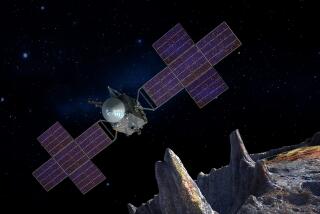Curiosity rover to head to mystery spot, touch first Martian rock
The Mars Curiosity rover is just a day away from hitting the road for its first Martian rock, once it wraps up a suite of tests on its 7-foot-long robotic arm, NASA officials said Wednesday.
Engineers at Jet Propulsion Laboratory in La Cañada Flintridge have been running tests since the Mars Science Laboratory rover, which landed Aug. 5, took a pit stop about 82 meters away from its landing site on Sept. 5. Itâs headed to Glenelg Intrigue â a spot that caught scientistsâ eyes because three different types of terrain meet there.
Mission scientists werenât yet ready to say exactly why Glenelg is so interesting â just that the mix of terrain looks like it might have an interesting geological story, and that it may provide the roverâs first potential drill target.
âStay tuned,â said deputy project scientist Joy Crisp, âbut at this time weâre still kicking around a lot of different hypotheses, and we just really donât want to stick our necks out yet.â
In the meantime, donât hit ârefreshâ on the NASA site every minute: The rover drives about 40 meters on the days that it moves, and Glenelg is 400 meters away. Ultimately, it will probably be more than a month before Curiosity uses the drill at the end of its arm to bore into a Martian rock, said mission manager Jennifer Trosper.
Before they reach Glenelg, however, the mission team members hope to use the roverâs mast camera to capture Marsâ moons, Phobos and Deimos, silhouetted against the sun â something that happens just once per Earth year, making the event a rare opportunity in the 2-year primary mission.
Curiosityâs ultimate target, however, is Mt. Sharp â a 3-mile-high mound in the middle of Gale Crater whose sedimentary layers may reveal whether the Red Planet was ever hospitable to life.
Follow me on Twitter @aminawrite.







